Shanghai High School International Division
| Shanghai High School International Division | |
|---|---|
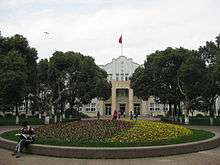 | |
| Address | |
|
400 Shang Zhong Rd. Xuhui, Shanghai People's Republic of China 200231 | |
| Information | |
| Type | International School (Exam school) secondary |
| Established | 1993 |
| CEEB code | 694242 |
| Principal | Ms. Lee Sin |
| Faculty | 100 (approx.) |
| Grades | 1–12 |
| Number of students | 2450 (approx.) |
| Affiliations | IBO UNESCO |
| Website | http://www.shsid.org/ |
Shanghai High School International Division (abbreviated SHSID, 上海中学国际部 in Chinese) is an international school in Shanghai, China, of Shanghai High School for students in grades 1–12. The sole language of instruction for all academic courses is English, and the school offers Honors Level courses with intense academic workload for gifted youth of all grades from elementary school to high school.[1] It is the earliest government supported international school to be founded in Shanghai. Although still a relatively new school compared to the history of Shanghai High School and other proven international schools, its students consistently matriculate to many of the top universities around the world.[2]
History
The Shanghai High School campus is situated on the historical site of the Lunghua Civilian Assembly Center, an internment camp established by the Empire of Japan for American and European citizens. James Graham Ballard was interned in the camp as an adolescent. His experiences there inspired the book (and subsequent film) Empire of the Sun.
On June 1, 1993, Shanghai High School approved the establishment of an International Division. SHSID enrolls more than 2,800 students from over 50 different nations and regions. Academics are separated into English and Chinese sections. The Chinese section is based on education in mainland China and education in Hong Kong. The English section is based on education in the United States, the IB Diploma Programme, and the Advanced Placement Program.[3] A division of one of the oldest high schools in Shanghai and all of China, SHSID is also known as one of the very first international schools established in the People's Republic of China and is a UNESCO school.[4]
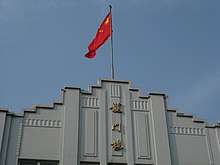
Statement
As an international school in China, SHSID developed educational goals to reflect a traditional background as well as goals to meet the needs of today’s talented students. The school is committed to educate students for the challenges of the future. SHSID provides progressive education in a multi-cultural environment, preparing students with global perspectives, and encouraging them to accept responsibilities and become competent in their studies.
Curriculum
Students take admittance exams prior to entering the school. The admittance exams and future move-up exams determine the level of the courses taken by all students. Levels include standard (S), standard plus (S+), honors (H) and honors plus (H+). Courses are also taken in preparation for the IB and AP programs which begin in the junior year and are modeled after the education system in the United States (even though most US schools offer AP programs starting from 9th grade).[5] Typical courses taken by students include Math, Chinese, English, Physics or Chemistry, History, Economics, Music, and Art. Biology and Geography are notable exceptions to the curriculum, and are available during the later years through choice. Both curricula follow a semester system. The grading systems is controlled directly by the principal, whose main intention is to display the talents and academic performance of IB students( one out of five SHSID students are enrolled in IB program) to the U.S. Universities.
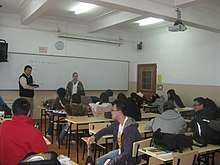
The IB Program
SHSID offers a variety of IB classes, including English (A1 and B), Chinese (A1 & B), Mathematics, Computer Science, Physics, Chemistry, Biology, Economics, History, Visual Arts, Music, and Psychology(SL only). Students can take the classes for 11th and 12th grade in preparation for the IB examinations in the May of their senior year. The IB coordinator is 蒋皓 (Dr. Erin Jiang), who is also the IB Chemistry instructor. SHSID is also a test center for the IB examinations and boasts an average IB score of 42.5, produced by only 30 IB students out of the approximate 250 class size(2015).
The AP Program
The AP program offers a limited selection of AP courses on a 2-year program similar to the IB program that can be taken in students' junior and senior years. Courses offered as of 2010 include (but is not limited to) AP Calculus, AP Statistics, AP Chinese, AP English Language and Composition, AP English Literature and Composition, AP Chemistry, AP Psychology, AP Microeconomics, AP Macro Economics, AP US History, and AP World History. Non AP-Class students may also apply to take the AP test at SHSID despite a discouragement from the school. To prevent the occurrence of failing grades and to produce a ' positive image' of it, the school requires applicants to take a test for eligibility, in which most of non AP students fail.
- The preliminary test policy has been removed since 2016
Tests
SHSID has a test-based curriculum, and students take 4 major examinations per class every semester: 2 monthly, 1 mid-term, and 1 final exams. Due to the usual 4-5 month length of one semester, each test is roughly allocated to a specific month. These tests take up a significant portion of the students' final grades, however, only the mid-term and final exam grades are sent to colleges during college applications. Taking into consideration the amount of classes each student is required to take, students will take approximately 32 major assessments each semester, or 64 major assessments per academic year.
SHSID is also a test site for TOEFL, PSAT, SAT, and ACT. The TOEFL internet-based testing is also open to students who do not attend SHSID. SAT and ACT is only available to SHSID students.
Optional classes
SHSID offers a wide range of "optional" classes, or electives. They accommodate the great variety of student interests, with courses such as "East-West Comparative Philosophy," "Contract Bridge," "Home Economics", and "Flower-Arranging." More popular courses include sports such as tennis and basketball, language classes such as Korean and Japanese, engineering courses such as electrical engineering and robotics, and culture-oriented classes like English movies, Chinese pottery and painting. Each student is required to choose one optional course every semester.
The Campus
The Shanghai High School campus spans an area of 223,617 square meters. The school campus has numerous buildings, two lakes, several small meadows, several gymnasiums, and various sports facilities. The campus exists on what was once a Japanese Prison camp during WWII, Lunghua Civilian Assembly Center, years before the establishment of the International Division...
Zhong Xing Building (中兴楼 in Chinese) is the regular class building for SHSID's high school freshman and sophomores. It is considered a masterpiece of modern engineering and safety standards. The scenic Zhongxing Lake, the most important lake of SHSID, is next to this building...
Xian Mian Building (先棉堂 in Chinese), located near the Laboratories and Shang Zhong road gate, is the building where high school juniors and seniors regularly have class.
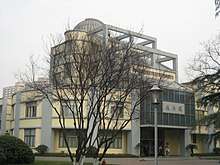
The Yifu Building of the school sports four stories of laboratories and an astronomical observatory on its roof. These laboratories allow for experiments to be conducted for chemistry, physics, and biology, which are roughly allocated to the first, second, and third floors, respectively. A modern analytical chemistry section was also opened recently for conducting advanced experiments. This includes mass spectrometry, IR and UV spectroscopy, gas chromatography, and atomic absorption spectroscopy.[6] There are also classrooms dedicated to robotics, electrical engineering, and simulated driving (elective courses)...
Students in Grade 7 and up, whose homes lie beyond the school busing areas, can apply to stay in the students’ dormitories.[7]
Athletic facilities
The school has a small number of facilities dedicated to physical education, including basketball courts, badminton courts, indoor and outdoor tennis courts, a gymnasium, volleyball courts, gymnastics/martial arts training rooms, Badminton/Ping Pong Building, a standard 400 meter track with a sandpit, soccer fields, and an Olympic-sized 50 meter swimming pool. The school also has a gym that students aren't allowed to use because it "belongs" to the country. The basketball courts also provide a wide area of concrete in which various sports competitions such as tug-o-war and dodgeball are held. They are also known to host occasional mock military exercises...
Art and music centers
SHSID's Art Center is built with two-story high ceilings made out of wood and windows placed high above. Inside the Art Center is the SHS History Exhibition. Oftentimes, the school's principal will lead a group of news reporters or the school's board of trustees into the Art Center to present them with SHS's alumni, martyrs, International Olympiad award winners, and principals...
Its staff include watercolor artist Fu Gang (傅钢) and studio arts instructor(s) for both the AP and IB Program's Visual Arts curriculum.
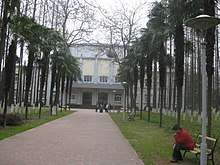
Auditoriums
Auditoriums of varying size dot the campus, the majority of them located in school buildings and are "assigned" to sections. The largest auditorium, the Big Auditorium (大礼堂), is located right behind the local division building. This is where school-wide events such as the Art Festival, Talent Show, and the Opening Ceremony are held. The auditorium building has a media center on its second floor.
Extracurricular activities
Student government
SHSID has a student governing body which goes by the acronym, ASB, or Associated Student Body. Members of the ASB are elected every year in each grade and are classified according to their sections (primary, junior, senior, etc.). The ASB is in charge of organizing school activities, such as inter-homeroom competitions, holiday parties/fairs, dances, academic competitions, and various services such as sending Christmas grams.
School events
The Art Festival and Talent Show are held annually (separately for each division primary, junior, or senior). Students may perform a variety of performing arts from short plays and piano recitals to rock bands and dance routines.
A sports day is also held annually and organized separately for each division (primary, junior, or senior). Competitions include Track and Field (100m, 200m, 400m, and 800m), Shot Put, Medicine Ball, High Jump, Long Jump, and 4 × 100 m Relays.
The school hosts an annual charity fair in which students set up stands and sell products to raise funds going to charity. This is often also a culturally active event, where international students put on display their respective countries' idiosyncratic foods, drinks, and trinkets. Similar to many other school events, the charity fair is specific to grade or section.
Every year, SHSID offers a group of volunteers and a body of participants for ACE, an annual charity event held in Shanghai. SHSID is one of the primary supporting international schools, contributing to tens of thousands in donations (RMB).[8] In 2009, more than 100 SHSID students participated in the event. In addition, several performances and artworks in ACE are authored by SHSID students.
The NEXUS
The Nexus is a student-run charity organization established at Shanghai High School International Division in 2008. As a branch of The Library Project, The Nexus works to raise funds and collect children's books to build libraries for elementary schools in the rural areas of China. To do so by holding charity events & activities in SHSID or between international schools in Shanghai, such events include basketball tournaments, fashion shows, dance competitions, book collections, etc. Every year, in winter, The Nexus organised high schools students to head out to the rural areas to help the elementary schools in those rural areas to build libraries and accomplish other tasks. In May 2012, Dragon TV (东方卫视) shot an hour long documentary about their charity works: it aired on June 21st.[9] The Nexus is looking at its tenth year since its establishment: there are more than 700 members in total making it the largest student organization at SHSID and among international schools in Shanghai.
Clubs
SHSID has many school clubs, such as literature club, art club, News club, Contract Bridge club, tennis club, biology club, astronomy club, jazz club, math club, Model United Nations club, World Scholar's Cup, History Club, novel-T club amongst others. These clubs have organized school activities such as poetry competitions, sports competitions, stargazing nights, math and science competitions, etc. Almost every student participates in several school clubs to satisfy their individual interests and curiosities, and during the lunch break the classrooms are often occupied with club meetings. The walls of the school building also give evidence to the great number of clubs, with wallpapers of all colors advertising club events.
SHSID's high school debate teams have won consecutive titles as champions in the Hong Kong-Shanghai Inter-city Real Time Debate on Net English Sections (8th and 9th sessions) [10][11] SHSID's History team was the consecutive champion in Asia in International History Bee and Bowl[12]
Sport Teams
SHSID is home to a diverse group of athletic teams. These teams include a table tennis, track and field, volleyball, badminton, baseball, swimming, basketball, soccer, and tennis team.
Notable people
Writer Richard Gordon was a teacher at SHSID from the fall of 2005 until his death in February, 2009.[13]
Jesse Munson and Michael Ford, band members of Shanghai local rock band Rainbow Danger Club, used to teach at SHSID.
Photo gallery
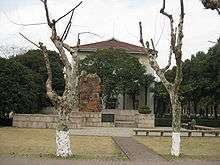 Rock Monument in SHSID which was recently removed and replaced with grass and a bust |
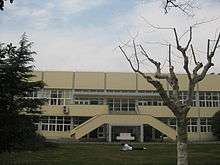 SHS cafeteria |
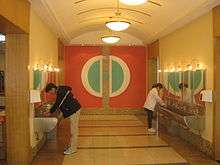 New international cafeteria |
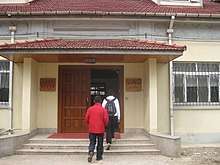 Art center |
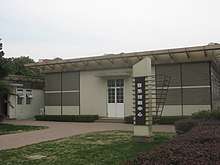 Music center |
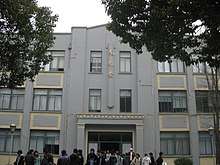 Xianmian Building, building for juniors and seniors |
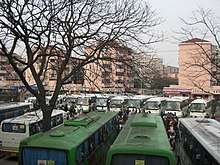 SHSID bus parking lot |
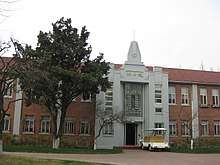 Principal's building |
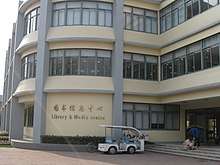 Library and media center |
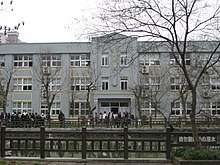 Zhongxing Building, building for freshmen and sophomores |
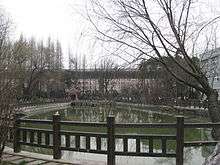 Zhongxing Lake |
See also
References
- ↑ "Archived copy". Archived from the original on 2009-08-04. Retrieved 2010-01-06.
- ↑ "Archived copy". Archived from the original on 2009-05-02. Retrieved 2010-01-06.
- ↑ Shanghai High School International Division School Description Archived 2008-09-20 at the Wayback Machine.
- ↑ WikiMapia: Shanghai High School
- ↑ "Archived copy". Archived from the original on 2009-08-04. Retrieved 2010-01-06.
- ↑ "Archived copy". Archived from the original on 2010-04-14. Retrieved 2010-02-07.
- ↑ "Archived copy". Archived from the original on 2011-10-07. Retrieved 2013-06-25.
- ↑ "Shanghai High School International Division". www.shsid.org. Retrieved 2018-04-06.
- ↑ http://tv.cntv.cn/video/C33904/e6c4a3893a5249e487c9cd57477ec4da
- ↑ http://www.jsit.net/debate-9/e-schedule.htm#EShanghaiHKSecondarySchoolsEnglishSection
- ↑ http://www.jsit.net/debate-8/e_schedule.htm#E
- ↑ http://www.ihbbasia.com/results/2015-2016-results/
- ↑ "悼念Mr. Richard Gordon". Shanghai High School International Division. 2009. Archived from the original on 2011-07-07. Retrieved 2009-11-28.